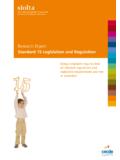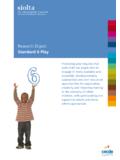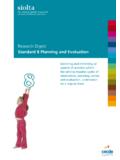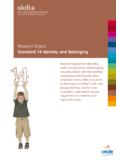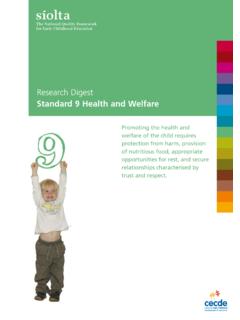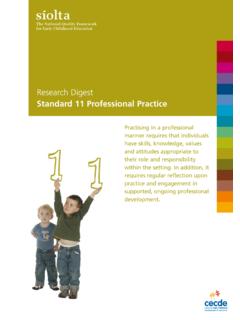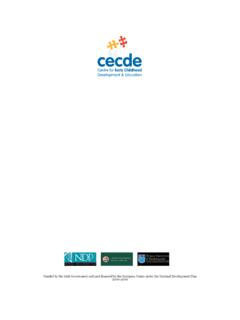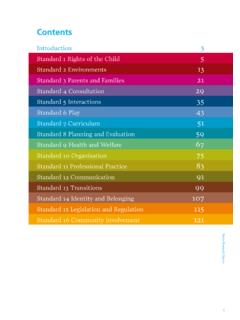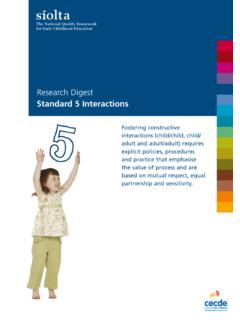Transcription of Research Digest - siolta.ie
1 The National Quality Framework for Early Childhood Educations oltaResearch Digest Standard 2 EnvironmentsEnriching environments, both indoor and outdoor (including materials and equipment) are well-maintained, safe, available, accessible, adaptable, developmentally appropriate, and offer a variety of challenging and stimulating experiences. Research Digest s olta Environments Research Digest s olta EnvironmentsIntroduction The outdoor and indoor environments develop children s confidence to express themselves, to make choices, to test ideas, to develop and practise skills, to make discoveries, and to persevere in the face of difficulty and uncertainty (National Council for Curriculum and Assessment [NCCA], 004:55).
2 Learning environments, both indoor and outdoor, should be motivating and appealing to all children. Children have different interests, needs and background experiences, and the materials, equipment and activites that the setting provides for them should be reflective of this diversity. Providing an environment where a child is encouraged and supported to have a positive sense of identity and belonging ( Research Digest /Standard 14: Identity and Belonging) is critical to her/his success as a learner. Similarly, there is an evident link between the environment and the interactions that take place within it ( Research Digest /Standard 5: Interactions).
3 The environment , therefore, requires careful consideration, in order to support relationships, play and curriculum implementation as key contexts for learning. Research Digest s olta EnvironmentsRecent ResearchWell planned indoor and outdoor environments Flexible indoor and outdoor environments, which address children s differing levels of maturity, and which are adapted to meet children s changing needs throughout the year, should be provided (Centre for Early Childhood Development and Education [CECDE], 005). The National Children s Nurseries Association (NCNA, 00 ) offers guidelines on the planning, design, building or altering of premises for an early childhood setting.
4 The provision of discrete areas for playing, sleeping, eating, bodily care, and storage of personal items is recommended, in addition to appropriate signage for all visitors and users of the setting. Sturdy, appropriately small-sized furniture, sanitary ware and equipment communicate an atmosphere of welcome and belonging for very small children. In planning a good learning environment , interest areas should be developed and arranged to facilitate easy movement and visibility. French ( 00 ) suggests ideas for the use of internal and external spaces, and outlines guidelines for establishing a learning environment and arranging and equipping areas.
5 Children themselves need to be participants in what adults are thinking, planning and doing on their behalf (Greenfield, 004). Ulrich ( 004) suggests that children should be reflected more personally in the environment , in order to enhance their self-identity and self-esteem. They recommend that practitioners consult with children and consider the following suggestions: Display children s project work Ensure that displays are at children s eye level Exhibit information about children s families Engage children in contributing photos or other materials for display Ensure that children s names are displayed Ensure that each child has some space that is personalised for her/himThe natural world can be appreciated and used as a foundation for creativity, play, sensory stimulation, and as a resource for continuity between settings (CECDE, 006).
6 Outdoor play space is sadly lacking in many early childhood settings, and outdoor experiences for non-mobile babies, toddlers and children with additional needs is particularly neglected. Bilton ( 00 ) suggests that there are certain principles to be adhered to when planning for effective early childhood experiences: Integration and combination of indoor and outdoor environments Availability of indoors and outdoors simultaneously for children Both indoors and outdoors should receive equal consideration in design, layout, resourcing, equipping, management, planning, evaluation, staffing, and adult interaction Outdoors is both a learning and a teaching environment where play is central to children s development and utilises effective modes of learning Children need to be able to control.
7 Change and modify their environment Staff have to be supportive towards the development of effective outdoor environments All of the above necessitates careful planning for a structured environment , to reflect the holistic nature of children s early learning and development (CECDE, 005).Adaptability and accessibilityAll aspects of the environment must demonstrate inclusivity and the flexibility to welcome children and adults with additional needs, as well as ensuring consistent ease of access and frequent use by all (CECDE, 005). Practitioners who understand child development and how children learn, and who aspire to support children s individual growth and development, construct 4 Research Digest s olta Environmentsenvironments which are adaptable and communicate a sense of respect and purpose (French and Murphy, 005).
8 Wheelchair and buggy ramps as well as wide double doors should be provided in services and, ideally, the setting should also be situated on the ground floor (French, 00 ). Well maintained and comfortable environmentsThe environments should be safe, hygienic, spacious and bright, and afford opportunities to rest, play, eat and have bodily care needs met. They should be regularly maintained and evaluated. Settings also need to have some adult-sized furniture for adults comfort. Both children and adults should enjoy their space (French, 00 ; French and Murphy, 005). The NCNA ( 00 ) observes that architectural design should extend beyond the basic requirements of accommodation in early childhood settings, and provide spaces to stimulate and interest the child.
9 Advice on the use of colour, light and shade is provided, along with the need to divide spaces both horizontally and vertically, with suggestions for creating mood. The importance of paying attention to the kitchen, in terms of structural finishes and food storage and preparation, is also outlined. The health and safety of all children and adults is paramount and all out-of-home settings must, therefore, conform to all relevant health and safety standards ( Research Digest /Standard 9: Health and Welfare). Although safe equipment is vital, the environment should still facilitate challenge, exploration and risk-taking (Greenfield, 004; CECDE, 006).
10 Providing challenging and enriching experiences The physical environments and experiences provided for children, indoors and out, have a powerful impact on their present and future (Greenfield, 004; Ulrich, 004). The experiences offered to children should support all children (and adults) to: Work independently and with others Actively explore and learn5 Research Digest s olta Environments Make and follow through on decisions Engage in first hand, real and creative experiences Solve problems Experience co-operative, symbolic and dramatic play (French, 007)Environments structured to meet the child s needs should provide a balance between the child s active approach to learning in terms of security and safety, and an appropriate level of risk (CECDE, 005).
